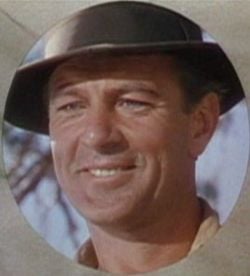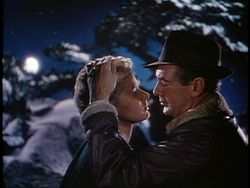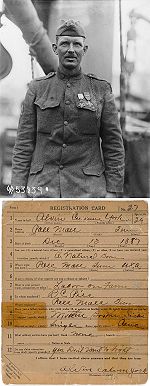Gary Cooper
| Gary Cooper | |
 Gary Cooper | |
| Birth name: | Frank James Cooper |
|---|---|
| Date of birth: | May 7 1901 |
| Birth location: | Helena, Montana, U.S. |
| Date of death: | May 13 1961 (aged 60) |
| Death location: | Los Angeles, California, U.S. (prostate cancer) |
| Height: | 6' 3" |
| Notable role(s): | Longfellow Deeds in Mr. Deeds Goes to Town Lou Gehrig in The Pride of the Yankees Robert Jordan in For Whom the Bell Tolls |
| Academy Awards: | Best Actor 1941 Sergeant York 1952 High Noon Academy Honorary Award (1961) |
| Spouse: | Veronica Balfe, stage name Sandra Shaw (1933 - 1961) (his death) 1 child |
Gary Cooper (born Frank James Cooper May 7, 1901 – May 13, 1961) was a two-time Academy Award-winning American film actor of English heritage. His career spanned almost 40 years beginning in the 1920s until the year of his death. He appeared in over one hundred films and was renowned for his quiet, understated acting style as well as his stoic, individualistic, emotionally restrained, at times intense screen persona; particularly well suited for the many Westerns he made.
Cooper received five Oscar nominations for Best Actor, winning twice. He also received an Honorary Award from the Academy in 1961. In 1999, the American Film Institute named Cooper among the Greatest Male Stars of All Time, ranking him at No. 11.
Childhood
Cooper was born Frank James Cooper in Helena, Montana, the son of a Bedfordshire, England farmer turned American lawyer and judge, Charles Henry Cooper, and Kent, England-born Alice (née Brazier) Cooper.[1] His mother hoped for their two sons to receive a better education than that available in rough-hewn Montana and arranged for the boys to attend Dunstable School between 1910 and 1913. Upon the outbreak of World War I, Mrs. Cooper brought her sons home and enrolled young Frank in a Bozeman, Montana high school.
When he was 13, Cooper injured his hip in an automobile accident. He returned to the ranch his parents owned near Helena to recuperate by horseback riding, at the recommendation of his doctor. Cooper started college at Montana Wesleyan (now defunct) in Helena, then transferred to Iowa's Grinnell College, studying graphics and art with intentions of pursuing a career as a commercial artist or a cartoonist. There he tried out, unsuccessfully, for the Drama Club. He attended Grinnell until the spring of 1924 but did not graduate. [2] He then returned to Helena, managing the ranch and contributing cartoons to the local paper. He spent a summer working as a seasonal ranger in Yellowstone National Park. In 1924, Cooper's father left the Montana Supreme Court bench and moved with his wife to Los Angeles. Unable to make a living as an editorial cartoonist in Helena, Cooper joined them, [3] reasoning that he "would rather starve where it was warm, than to starve and freeze too." [4]
Hollywood
Failing as a salesman of both electric signs and theatrical curtains and as a promoter for a local photographer,[5] the 6 ft 3 in (190 cm) Cooper found that he could earn money as an "extra" in the motion picture industry, usually cast as a cowboy or working as a stuntman. He is known to have been in an uncredited role in the 1925 silent Tom Mix Western, Dick Turpin [6]. He changed his name to Gary that same year, following the advice of casting director Nan Collins, who felt it evoked the "rough, tough" nature of her native Gary, Indiana.[7] "Nan came from Gary, Indiana and suggested I adopt that name," Cooper said later. "Good thing she didn't come from Poughkeepsie." A year later, he had screen credit in a two-reeler, Lightnin' Wins, with actress Eileen Sedgewick as his leading lady. After the release of this short film, he accepted a long-term contract with Paramount Studios.
"Coop", as he was called by his peers, went on to appear in over 100 films. He became a major star with his first sound picture, The Virginian, in 1929. The lead in the screen adaptation of A Farewell to Arms (1932) and the title role in 1936's Mr. Deeds Goes to Town furthered his box office appeal. Cooper was producer David O. Selznick's first choice for the role of Rhett Butler in the 1939 film Gone with the Wind.[8] When Cooper turned down the role, he was passionately against it. He is quoted as saying, "Gone with the Wind is going to be the biggest flop in Hollywood history. I’m glad it’ll be Clark Gable who’s falling flat on his nose, not me".[9][10] Alfred Hitchcock wanted him to star in Foreign Correspondent (1940) and Saboteur (1942). Cooper later admitted he had made a "mistake" in turning down the director. For the former film, Hitchcock cast look-alike Joel McCrea instead.
In 1941, he won his first Academy Award for Best Actor for his performance as the title character in Sergeant York. The real Alvin York was adamant about authorizing only Gary Cooper as the actor to portray him in the movie about his life.
In the summer of 1940 Ernest Hemingway invited Cooper to read his latest novel, still in galley form, "For Whom the Bell Tolls." Cooper immediately identified with the story and, in particular, the part of Robert Jordan. "That's good," Hemingway replied. "It was written for you." A film adaptation of the novel directed by Sam Wood was released in 1943 starring Cooper and Ingrid Bergman. It was nominated for 9 Academy Awards, including best picture, best actor and best actress; however, only the Greek actress Katina Paxinou won the Oscar for her supporting role portrayal of Pilar.
In 1952, Cooper won his second Best Actor Academy Award for his performance as Marshal Will Kane in High Noon, considered his finest role. Ill with an ulcer, he wasn't present to receive his Academy Award in February 1953. John Wayne was asked to accept it on his behalf; ironic, in light of Wayne's statement, calling the film "un-American."[11] Cooper had previously testified before the House Committee on Un-American Activities in October 1947. At that time, even though he did not name names, he was considered a friendly witness. However, after his role in High Noon, described by some as a western allegory for the blacklisting occurring at that time in Hollywood, and his subsequent strong defense against right-wing attacks directed toward blacklisted screenwriter Carl Foreman, Cooper was seen by many as a man more of principle than politics.
Cooper continued to appear in films almost to the end of his life. Among his later box office hits was his portrayal of a Quaker farmer during the Civil War in William Wyler's Friendly Persuasion in 1956. His final motion picture was a British film, The Naked Edge (1961), directed by Michael Anderson. Among his final projects, he served as narrator for an NBC documentary, The Real West, in which he helped clear up several myths about famous Western figures.
Private life
Gary Cooper had several high-profile relationships with various actresses throughout his career, including Clara Bow, Lupe Vélez, American-born socialite-spy Countess Carla Dentice di Frasso (née Dorothy Caldwell Taylor, formerly wife of British pioneer aviator Claude Grahame-White), Patricia Neal, Grace Kelly, and Marlene Dietrich.
On December 15 1933, Cooper wed Veronica Balfe, (May 27, 1913 - February 16 2000). Balfe was a New York Roman Catholic socialite who had briefly acted under the name of Sandra Shaw. She appeared in the film No Other Woman, but her most widely seen role was in King Kong, as the woman dropped by Kong. Her third and final movie was Blood Money. Her father was governor of the New York Stock Exchange, and her uncle was Cedric Gibbons. During the 1930s she also became the California state women's Skeet Champion. They had one child, Maria, now Maria Cooper Janis, married to classical pianist Byron Janis.
Veronica introduced her husband to tennis, golf and skiing, and he in turn took her fishing. News reporters had to face the loss of what they'd so happily dubbed "Paramount's paramount skirt-chaser". If Cooper was still a 'threat' to his leading ladies, he became discreet about it. Cooper separated from his wife, Veronica, between 1951 and 1954. Reportedly, Cooper became a Roman Catholic in 1958.
He was friends with Ernest Hemingway, and spent many vacations with the writer in the winter wonderland of Sun Valley, Idaho.
Cooper was too ill to attend the Academy Awards ceremony in April 1961, so his close friend James Stewart accepted the honorary Oscar on his behalf. Stewart's emotional speech hinted that something was seriously wrong, and the next day newspapers all over the world ran the headline, "Gary Cooper Has Cancer". A month later, Cooper was dead of prostate cancer. He had undergone surgery for the cancer which had spread to his colon in the previous year, but as there were no means of monitoring the progress of cancer in those days it had then spread to his lungs and finally to his bones. He was first interred at Holy Cross Cemetery in Culver City, California, however, years later, his body was moved to Sacred Heart Cemetery, Southampton, New York.[12]
Legacy
For his contribution to the film industry, Gary Cooper has a star on the Hollywood Walk of Fame at 6243 Hollywood Blvd. In 1966, he was inducted into the Western Performers Hall of Fame at the National Cowboy & Western Heritage Museum in Oklahoma City, Oklahoma. His name has also been immortalized in Irving Berlin's song "Puttin' on the Ritz" with the line, "Trying hard to look like Gary Cooper, (super duper)".
Charlton Heston often cited Cooper as a childhood role model, and later got to work with him on The Wreck of the Mary Deare (1959). Heston praised Cooper for doing his own stunts despite his age and poor health. Morgan Freeman while being interviewed on The Adam Carolla Show in 2007, stated that watching Cooper as a young man had inspired him to act.
Filmography
Features
|
(see note below)
|
|
- Note: imdb.com has speculated, but has not confirmed, that Cooper may have been an uncredited extra in the 1923 film The Last Hour. Other sources indicate that Cooper was a student at Grinnell College in 1923, and did not move to California until 1925.
Short Subjects
- The Spider's Net (1924)
- The Slippery Pearls (1931)
- The Voice of Hollywood No. 13 (1932)
- Hollywood on Parade (1932)
- The Hollywood Gad-About (1934)
- Star Night at the Cocoanut Grove (1935)
- La Fiesta de Santa Barbara (1935)
- Lest We Forget (1937)
- Screen Snapshots: Seeing Hollywood (1940)
- Screen Snapshots Series 19, No. 6 (1940)
- Hedda Hopper's Hollywood No. 3 (1942)
- Memo for Joe (1944)
- Snow Carnival (1949) (narrator)
- Screen Snapshots: Motion Picture Mothers, Inc. (1949)
- Screen Snapshots: Hollywood Premiere (1955)
- Screen Snapshots: Glamorous Hollywood (1958)
| Awards | ||
|---|---|---|
| Preceded by: James Stewart for The Philadelphia Story |
Academy Award for Best Actor 1941 for Sergeant York |
Succeeded by: James Cagney for Yankee Doodle Dandy |
| Preceded by: Humphrey Bogart for The African Queen |
Academy Award for Best Actor 1952 for High Noon |
Succeeded by: William Holden for Stalag 17 |
| Preceded by: Fredric March for Death of a Salesman |
Golden Globe Award for Best Actor - Motion Picture Drama 1953 for High Noon |
Succeeded by: Spencer Tracy for The Actress |
| Preceded by: Charles Chaplin for The Great Dictator |
NYFCC Award for Best Actor 1941 for Sergeant York |
Succeeded by: James Cagney for Yankee Doodle Dandy |
Notes
- ↑ Arce, Hector. Gary Cooper: An Intimate Biography, New York, William Morrow & Co., 1979, pp. 17-18
- ↑ Current Biography 1941, pp 170-71
- ↑ Arce, Hector. Gary Cooper: An Intimate Biography, New York, William Morrow & Co., 1979, pp. 22-23
- ↑ Current Biography 1941
- ↑ Arce, Hector. Gary Cooper: An Intimate Biography, New York, William Morrow & Co., 1979, pp. 22-23
- ↑ imdb.com
- ↑ Arce, Hector. Gary Cooper: An Intimate Biography, New York, William Morrow & Co., 1979, p. 25
- ↑ Selznick, David O. (2000). Memo from David O. Selznick. New York: Modern Library, 172-173. ISBN 0-375-75531-4.
- ↑ GoneMovie -> Biography Gary Cooper
- ↑ Paul Donnelley (June 1, 2003). Fade To Black: A Book Of Movie Obituaries, 2nd Edition. Omnibus Press.
- ↑ Arce, Hector. Gary Cooper: An Intimate Biography, New York, William Morrow & Co., 1979, p. 252
- ↑ Maria Cooper Janis, Gary Cooper Off Camera: A Daughter Remembers, Harry N. Abrams, Inc.: New York, NY (1999), page 167
ReferencesISBN links support NWE through referral fees
- Arce, Hector. Gary Cooper: An Intimate Biography. Bantam Books (July 1980). ISBN 978-0553141306.
- Janis, Mary Cooper. Gary Cooper Off Camera: A Daughter Remembers (Hardcover). Harry N. Abrams (November 1, 1999). ISBN 978-0810941304.
- Meyers, Jeffrey. Gary Cooper (Paperback). Aurum Press Ltd (March 25, 2005). ISBN 978-1845130466.
- Selznick, David O. Memo from David O. Selznick : The Creation of "Gone with the Wind" and Other Motion Picture Classics, as Revealed in the Producer's Private Letters, Telegrams, Memorandums, and Autobiographical Remarks (Paperback). Modern Library; Modern Library Pbk. Ed edition (March 7, 2000). ISBN 978-0375755316.
External links
- Gary Cooper at the Internet Movie Database
- Gary Cooper at the TCM Movie Database
- The Gary Cooper Pages
- Find-A-Grave profile for Gary Cooper
- Photographs of Gary Cooper
- Profile @ Turner Classic Movies
| Persondata | |
|---|---|
| NAME | Cooper, Gary |
| ALTERNATIVE NAMES | Cooper, Frank James |
| SHORT DESCRIPTION | actor |
| DATE OF BIRTH | May 7, 1901 |
| PLACE OF BIRTH | Helena, Montana, U.S. |
| DATE OF DEATH | May 13, 1961 |
| PLACE OF DEATH | Los Angeles, California, U.S. |
Credits
New World Encyclopedia writers and editors rewrote and completed the Wikipedia article in accordance with New World Encyclopedia standards. This article abides by terms of the Creative Commons CC-by-sa 3.0 License (CC-by-sa), which may be used and disseminated with proper attribution. Credit is due under the terms of this license that can reference both the New World Encyclopedia contributors and the selfless volunteer contributors of the Wikimedia Foundation. To cite this article click here for a list of acceptable citing formats.The history of earlier contributions by wikipedians is accessible to researchers here:
The history of this article since it was imported to New World Encyclopedia:
Note: Some restrictions may apply to use of individual images which are separately licensed.


